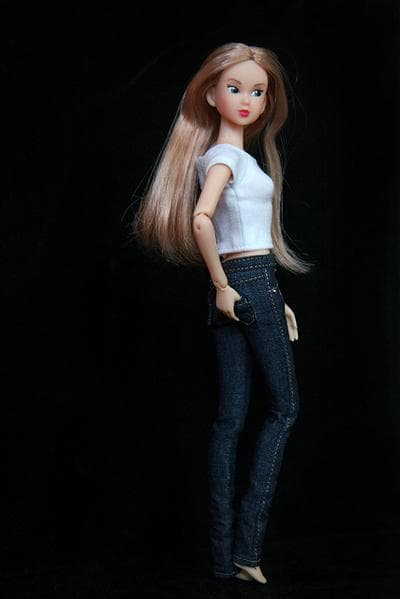Advertisement
'Skinny Jeans' World: How Do We Protect Daughters From Eating Disorders?
Guest Contributor
“Sometimes it is necessary to reteach a thing its loveliness” -- Galway Kinnell
After years and tears spent treating girls with eating disorders, I found myself pregnant — in my 40s — with a daughter.
Penelope is now 10, and suddenly, everything I'd preached and chiseled and chipped and interpreted in my office is getting put to the test. How was I going to try to prevent my own child from having an eating disorder? How would I prevail against a culture of young girls in short shorts, strappy tops and frankly lewd fashion, where my 4th grader must choose between "boyfriend jeans" and "skinny jeans"? As I had told my patients: "Many girls entertain diets — not everyone gets an eating disorder."
Still, I reviewed the early dangers for developing such a disorder — flipping through my own brain for knowledge.
1. Genetics
We had some family history of mood disorders but nothing that seemed so severe it couldn’t be tempered by attentive parenting.
2. Home obsession with foods
I made absolutely sure that nothing in my house was low-fat, low-calorie and insisted that dessert was part of the meal if you ate your ‘growing foods” a useful phrase I learned from her pre-school teacher.

3. Range of affect (or, enough feelings)
Yup, no problem there. My house was never one where feelings were suppressed. In fact, I might have spent too much time inquiring what my child thought or felt. I was politely interrupted. "Mom,” she said, "I’m watching the cars outside" or "Making a friendship bracelet" or "Telling myself a story."
4. Too much affect
Yes, I wanted to tone this down. She neded to learn resilience — that horrible feelings, the dementors of loneliness, sadness and intense anger can be survived. She needed to endure them and learn to soothe herself. I reminded myself of this as I clenched my nails into my hand while she hurled about in her crib.
5. Too much talk about appearance
I failed on this. I could not even try to stop my outpouring of sheer joy at her natural beauty. I was, as C.S. Lewis said, “surprised by joy” in this department. I craved her attention like a jilted suitor. But it amuses both of us — and possibly helped her — that I would joke about my "separation issues.” I believe I gave her the freedom to express those same feelings and a good many more.
6. A sense of purpose
We are currently working on this. The most effective cure for the most recalcitrant eating disorders is — surprisingly — community service.
Like people in a nursing home who thrive when they care for a plant, children do better when they feel their effect on the world is real. I ramped up on chores, folding laundry, carrying grocery bags. A child who danced for hours could use her legs to help me.
7. Perfectionism
When my daughter was three, I saw a child in her nursery school crumple up a drawing, burst into tears and throw it away. I vowed I would do my best to melt perfectionist thinking. We practiced making mess-ups into other shapes. We practiced turning pages over and writing on the backs of things. I told her often, purposefully, about my own mess-ups, what caused them and how I still was growing. I learned to ask her if she felt proud of something — not to tell her that I was instead.
8. Culture
This huge piece of influence is almost indescribable. Culture is written across the bottom of shorts, the straps of shirts, the piercings and tattoos called body art. Wherever you stand on particular trends, it's hard to deny that a new, frankly lewd look is popular. Somehow feminism has been replaced by exhibitionism. Reality TV and instagram make looks all that matters. Sexting seems a natural outcome from this atmosphere.
All I could do on this front is to hold my ship fast at home. I batten down the hatches. I encourage critical commentary about dolls that are too thin, pictures of girls who were too thin. Movies which demean fatties. I censure TV and books about mean girls.
What I cannot plan for is my daughter; her own self. She dances (at a studio she feels is like a second home). All I did was steer her toward the one that has the most diverse group of girls' strong bodies I’ve seen.
But she is at a liminal age and it terrifies me. She is a perfectionist at times and it drives me nuts. I never want her to look at herself with loathing, to pinch a part of her skin with disgust and wish it gone. I detest the bonding that begins — very soon — when girls turn to each other and say: "I’m fat." And the response — rather than saying “Don’t be ridiculous" or "How boring," the only scripted response is: “Are you kidding, I’m fat. You’re thin.”
A few days ago we went to buy jeans — she’d grown again. I was sick to see that our choices were reduced to two categories: "Skinny jeans" or "Boyfriend jeans.’ Those are her choices.
Is she skinny or does she have a boyfriend whose clothes she borrows? She's 10. Why can’t the pants simply be called straight or baggy?
I don’t know how we can hold back this enormous wave surging toward our girls. But we must keep trying. I hope I will not be reteaching Penelope her loveliness as I do, here, in my office, every day at work.
Katy Aisenberg is a psychologist in private practice in Cambridge
This program aired on May 14, 2013. The audio for this program is not available.